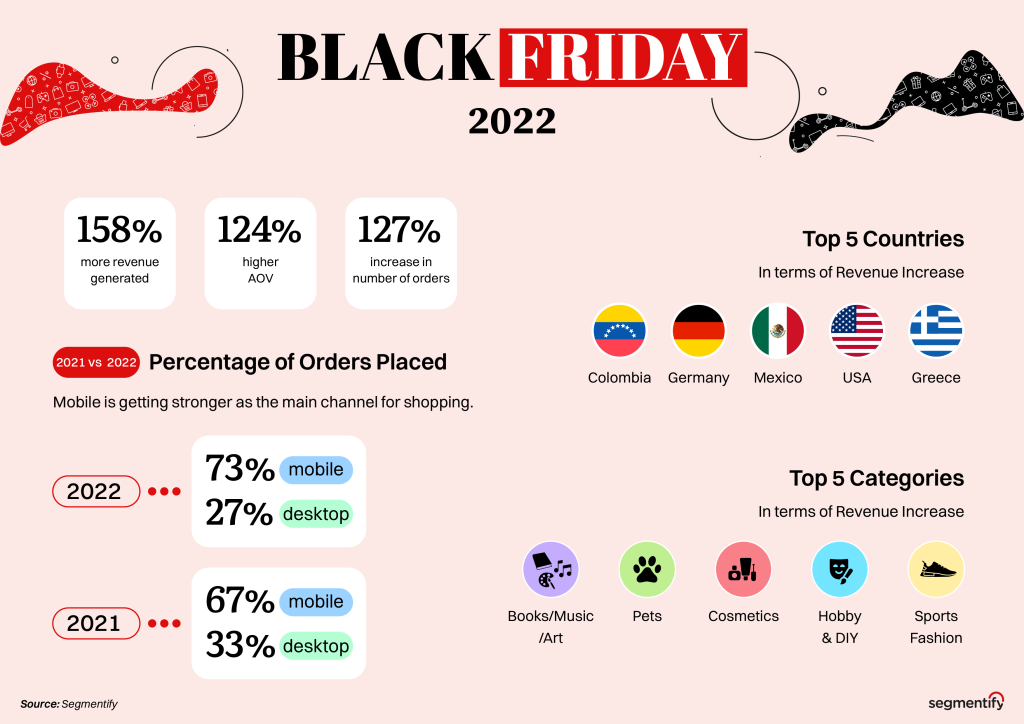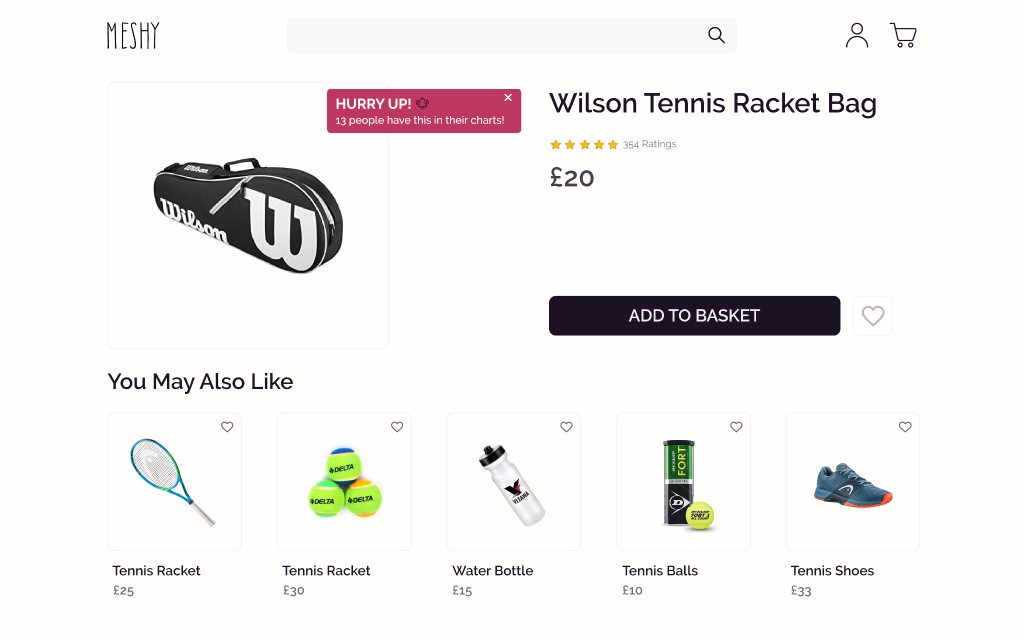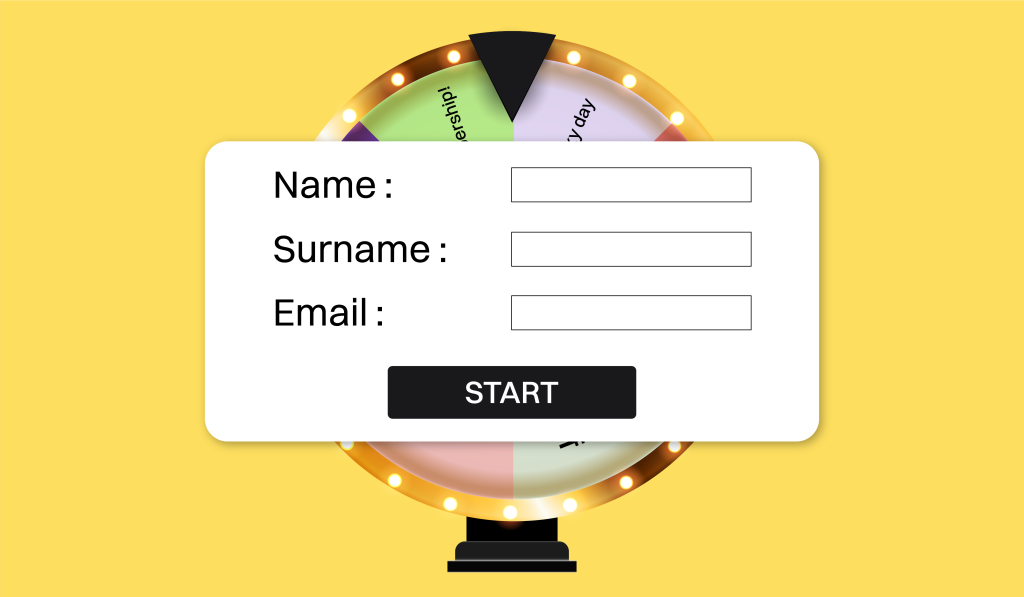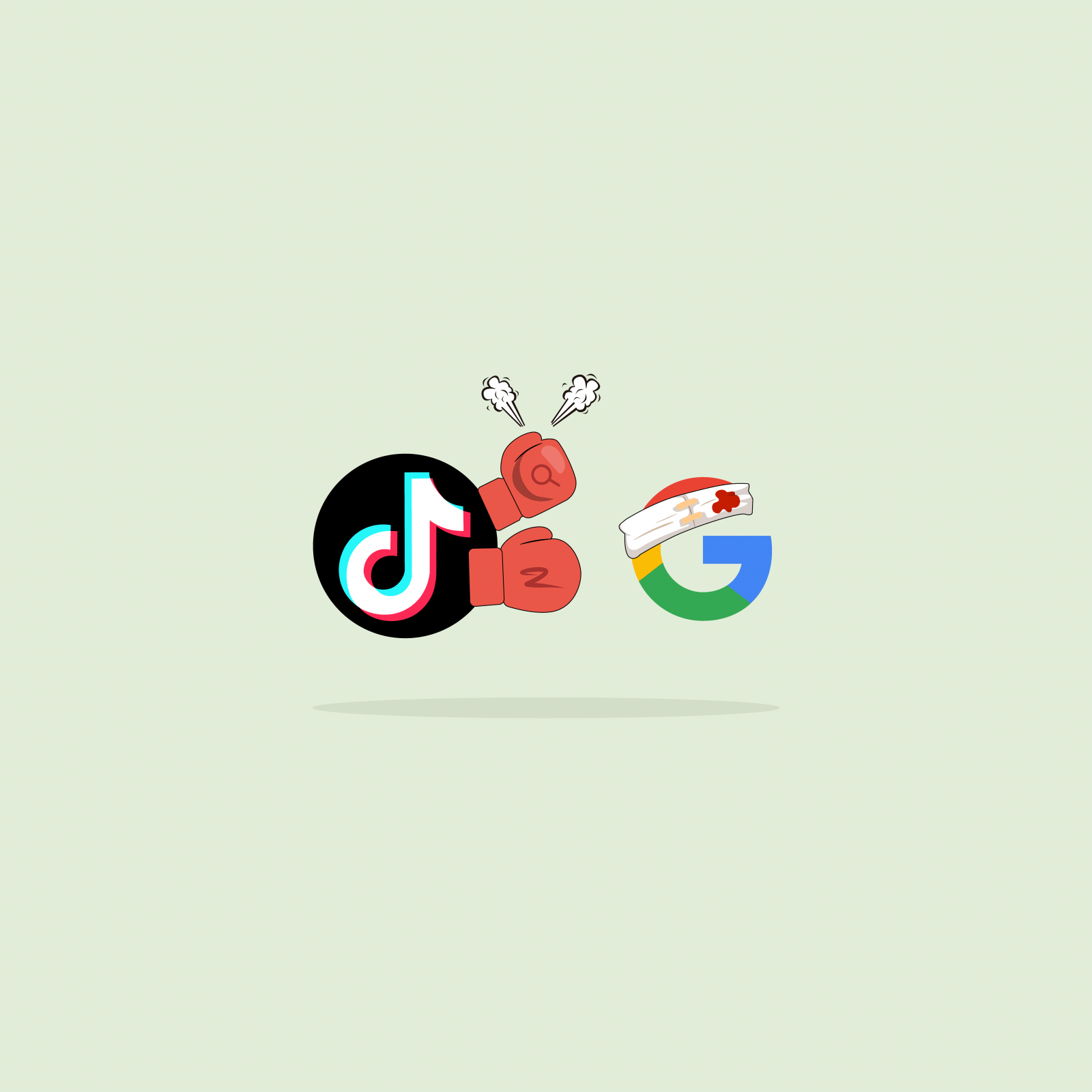Our websites use cookies. By continuing, we assume your permission to deploy cookies as detailed in our Privacy Policy.
Black Friday Marketing Best Practices 2024
Black Friday might be just one day on the calendar, but it is only the beginning of the biggest sales season for eCommerce. It is the “unofficial” start of the shopping season because it’s closely followed by Cyber Monday and Christmas.
This article will discuss the strategies you can use to elevate your Black Friday marketing campaigns.
Mark your calendars, and let’s start!
Key Takeaways
- Longer than necessary page loading time is a huge deal-breaker. The ideal page load time is 1 to 2 seconds, as anything longer than that costs significant revenue loss.
- Leverage your online presence (website, app, and social media), use cross-channel marketing to connect and convert, and employ real-time analytics and on-site engagement solutions to enhance the user experience.
- Have a post-Black Friday follow-up strategy to turn the first-time customers you’ve gained with your Black Friday marketing into loyal customers.
Black Friday Marketing Guide 2024: 10 Strategies to Try
Brands of various sizes and across different industries all participate in Black Friday, so having a solid Black Friday marketing strategy is of utmost importance to attract new customers and cultivate existing relationships.
Take a look at these must-haves for a bulletproof Black Friday marketing strategy, and plan your Black Friday marketing campaign around these checkpoints to ensure that things run as smoothly as possible.
1. Optimise Website Performance
Black Friday is one of the busiest times of the year for eCommerce. During this hectic period, the last thing you want is a website that slows down or crashes randomly, right?
Don’t underestimate your traffic load; make sure your website can handle the extra traffic. Consumers have low levels of patience. They’ll expect a smooth shopping experience and leave your website in case of a slow load time or crashes.
The ideal page load time is 1 to 2 seconds, as anything longer than that costs significant revenue loss. For each additional second your website takes to load, the average eCommerce conversion rate decreases by 0.3%.
- Plan to account for possible server problems due to too much traffic and test your pages for glitches. Glitches during the checkout process are especially not welcome by visitors.
- You can use website speed test tools to measure page loading times. Such tools tell you which areas need improving for better website performance.
- Don’t forget image optimisation as well since it affects website performance, SEO rankings and user experience.
2. Optimise for Website for Mobile
To fully leverage your online presence for Black Friday marketing campaigns, optimising for a wide array of devices and screen resolutions, extending beyond just desktop platforms is essential. And you can’t ignore that mobile design is a massive part of our lives:
- 6.92 billion people, 85.95% of the global population, own smartphones.
- Adults in the US spend 2 hours and 55 minutes on average on their smartphones devices per day.
- Google accounts for 96.46% of the global mobile search engine market worldwide.
- 59% of shoppers in the US use their phones while inside stores to compare prices or hunt for discounts and coupons.

Here’s what you need for website mobile optimisation for the best Black Friday marketing period:
- A responsive website design instead of an m-dot subdomain
- Applying image optimisation best practices
- Implementing compression and minification techniques
3. Leverage Real-Time Analytics
As you gear up for your Black Friday marketing shenanigans, the strategic selection of products to spotlight gains even greater potency through the integration of cutting-edge data analytics tools.
Real-time analytics play a crucial role in preparing Black Friday marketing campaigns, as they allow businesses to make informed decisions, optimise strategies, and capitalise on opportunities as they unfold during the frenzied shopping period. Here’s why real-time analytics are essential for Black Friday marketing campaigns:
- Timely decision-making: Black Friday is a time-sensitive event with intense competition. Real-time analytics provide up-to-the-minute insights into consumer behaviour, sales trends, website traffic, and inventory levels. This information enables marketers to make quick and informed decisions, such as adjusting pricing, changing promotional tactics, or reallocating resources based on current market conditions.
- Inventory management: Black Friday often involves high demand and fluctuating inventory levels. Real-time analytics help businesses monitor inventory in real-time, ensuring that products are in stock and available for purchase. This prevents stockouts, minimises overstocking, and maximises sales opportunities.
- Fraud detection and prevention: Black Friday is also a time when fraudulent activities tend to increase. Real-time analytics can identify suspicious transactions, patterns, or activities that may indicate fraud, enabling businesses to take immediate action to prevent losses and protect both customers and the company.
- Budget allocation: Black Friday marketing campaigns often involve significant budgets across various channels. Real-time analytics provide insights into which channels and campaigns are generating the highest return on investment (ROI) in real time, allowing to allocate budgets to the most successful areas for maximum impact.
In essence, real-time analytics empower brands to adapt, refine, and optimise their Black Friday marketing strategies on the fly, ensuring they can respond effectively to the dynamic and rapidly changing landscape of this high-stakes shopping event. By leveraging real-time insights, businesses can enhance customer experiences and achieve their Black Friday marketing goals.
4. Landing Page Optimisation
Landing pages are fundamental for Black Friday marketing campaigns. Their purpose is to create awareness and drive traffic to a specific page.
Creating specific landing pages for different Black Friday marketing campaigns will help your visitors find what they are looking for easily and quickly.
Pay attention to these points for a successful landing page:
- Page loading time: We’ve already been over this, but page loading time is (and we can’t stress this enough) critical. You have about 15 seconds before someone leaves your website. They will exit the page faster if there’s trouble with the loading speed.
- Engaging copy: Using “Black Friday” in the headline is usually a given, but consider emphasising the discounts you’re offering as. Another option would be to add a specific discount code.
- Page design: Keep it simple and elegant. Colour schemes, visuals, and font types and sizes should be harmonious and easy to follow and look at. You don’t want to hurt anyone’s eyes, do you?
- Call-to-actions: Use strong but clear CTAs to lead users to a specific page or get them to join an emailing list for the upcoming Black Friday sales.
5. Improve Product Detail Pages
A Product Detail Page (PDP) refers to a webpage that provides comprehensive information to customers and buyers regarding a specific product. This information encompasses details about colour choices, sizes, materials, pricing, shipping alternatives, and additional relevant factors.
And since we’re discussing Black Friday marketing campaign best practices, an optimised product detail page carries great weight.

An optimised product detail page is one that is optimised for website performance best practices and with easy-to-digest information for the best user experience.
- Product descriptions: A product description usually involves a body, title, headlines, tags, meta title, and meta description. The goal is to inform, engage, and excite the customers. But don’t make it too long; it should be easily skimmable. Include relevant keywords for SEO.
- Product images and videos: Show the item from multiple angles, and if you can, show how it’s being used. Your customers are not just buying a new TV but countless movie nights with their loved ones.
- Ratings and reviews: Customers depend on social proof to gauge the value of a product before making a purchase decision. Presenting a balanced and impartial stance by including both positive and negative feedback is essential.
6. Provide Transparent Information About Return and Shipping Policies
Effective return policies and affordable (or free) shipping fees are pivotal in boosting conversion rates, especially for Black Friday marketing campaigns. These strategies reduce buyer hesitations and motivate them to finalise their purchases.
By offering a transparent return policy, you’ll showcase your unwavering belief in your products’ excellence. Simultaneously, this policy reassures customers that should the product not meet their expectations, they have a straightforward process to return it, further enhancing their shopping confidence. This becomes even more pertinent during the Black Friday rush when shoppers are actively seeking valuable deals and reassurances.
As part of your Black Friday marketing strategy, ensure a seamless eCommerce experience:
- Offer transparent shipping rates. This minimises friction and establishes clear expectations; unexpected shipping or tax costs are the primary cause of cart abandonment.
- Make sure shipping information is readily accessible on your product detail pages.
7. Use Social Media Advertising
It’s been quite a while since social media platforms have become more than just places to connect with friends. They have been a big part of a marketer’s arsenal for the good part of the past decade:
- 54% of social media users use social media platforms for product research, and 71% are more likely to purchase based on social media referrals.
- Younger generations are using TikTok as a search engine rather than Google.
- 49% of TikTok users say the platform helped them make purchasing decisions.
But how will social media advertising help with Black Friday marketing?
- Wider reach, precise targeting: Advanced targeting options allow you to pinpoint your ideal customers based on age, location, interests, behaviours, and more. This precision targeting ensures that your Black Friday promotions are seen by those most likely to convert.
- Engagement and interaction: Social media isn’t just about broadcasting messages; it’s a two-way street. Engage with your audience through interactive content, polls, contests, and giveaways. This engagement builds a sense of community and amplifies your brand’s reach through user-generated content.
- Retargeting and remarketing: Capture the attention of users who have previously interacted with your brand or visited your website. By reminding them of their interest and showcasing relevant Black Friday deals, you can effectively nudge them toward making a purchase they may have considered. Learn more about Segmentify’s Personalised Ads.
8. Use Gamification
Gamification is the process of integrating game elements, mechanics, and design principles into non-game contexts, such as Black Friday marketing campaigns.
By leveraging the innate human desire for competition, achievement, and rewards, you can construct engaging and interactive scenarios that motivate customers to engage and remain loyal.

Black Friday presents the perfect opportunity to leverage gamification as consumers are on the lookout for deals, discounts, and unique experiences. By tapping into the inherent thrill of gaming, you can create a sense of urgency, fun, and anticipation that drives customers to explore your offerings and take action.
Spin-the-Wheel pop-ups, for example, are excellent solutions for an engaging Black Friday marketing campaign.
Check out how D&R, an online bookstore, increased AOV by 73% with gamification during Black Friday 2022.
- Design a virtual spin-the-wheel game that customers can engage with on your website or through your mobile app.
- Offer discounts, special offers, or even exclusive prizes that customers can win with each spin. This not only makes the shopping experience more interactive but also increases the likelihood of purchase as customers strive to win big.
Incorporating gamification into your Black Friday marketing strategy can significantly impact customer engagement and sales. By tapping into the excitement and enjoyment of gaming, you’ll not only create a memorable experience but also encourage customers to interact with your brand on a deeper level.
9. Have a Black Friday Email Marketing Strategy
During the highly anticipated Black Friday period, email marketing assumes an even more vital role in captivating and converting customers, a scenario eagerly anticipated by both brands and consumers.
The correct Black Friday email marketing strategy empowers you to connect with a vast audience, foster anticipation, and generate sales amid the bustling shopping season, presenting attractive deals, discounts, and promotions. Anticipate the following gains from Black Friday email marketing campaigns:
- Direct and personalised communication
- Enhanced brand loyalty
- Loyal customer base
- Quantifiable outcomes
- Remarkable Return on Investment (ROI)
Read more: Black Friday Email Marketing Strategy Best Practices
10. Cross-Sell and Upsell
Cross-selling and upselling can be used to encourage customers to spend more and increase the AOV during the Black Friday period.
Use these Black Friday marketing strategies to increase AOV:
- Bundle offers: Create bundles of related products at a discounted price, encouraging customers to buy complementary items.
- Post-purchase recommendations: After a customer completes a purchase, show them recommendations for products that pair well with their chosen item.
- Frequently bought together: Display a section showing products frequently purchased together, enticing customers to add more items to their cart. Get the help of tools like Segmentify Analytics.
- Tiered discounts: Offer increasing levels of discounts based on the total amount spent, encouraging customers to add more items to their cart.
- Limited-time upgrades: Present time-sensitive offers where customers can upgrade to a higher-value product for a reduced cost.
- Free shipping threshold: Set a minimum order value for free shipping, encouraging customers to add more items to their cart to qualify.
- Extended warranty or support: Propose extended warranty plans or premium customer support for an additional fee when purchasing electronics or appliances.
Communicate the value and benefits of cross-sell and upsell options clearly to customers through well-designed visuals and compelling copy. Tailor your cross-selling and upselling strategies based on customer segments and demographics for maximum relevance.
Remember that ethical and customer-centric marketing practices are crucial. Always prioritise the customer’s needs and preferences, providing genuine value with your Black Friday marketing campaigns.
Follow Up with Customers After Black Friday
After the dust settles from the Black Friday frenzy, your marketing efforts are far from over. In fact, this is where the real magic happens – cultivating lasting relationships with those who engaged with your brand during the shopping extravaganza.
A well-executed post-Black Friday follow-up strategy can transform transient transactions into enduring customer loyalty.
- Sustain the excitement with exclusive offers: Keeping the momentum alive is essential. Extend the Black Friday excitement by offering exclusive post-event deals to your recent customers. This not only rewards their participation but also encourages them to explore more of what your brand has to offer
- Nurture brand loyalty: Beyond the discounts, the heart of post-Black Friday follow-up lies in delivering consistent value. Engage your audience with relevant content that resonates with their interests and recent purchases. By sharing helpful information, product insights, and engaging stories, you’ll position your brand as a trusted source of expertise and entertainment, reinforcing the bond between your customers and your business.
The period after Black Friday is a golden opportunity to deepen connections, fuel customer loyalty, and set the stage for a lasting relationship beyond a single shopping event.
Wrapping Up
Black Friday has evolved into a cornerstone of modern marketing strategies, driving both anticipation and fervour among consumers. As explored in this comprehensive Black Friday Marketing Guide for 2024, success during this shopping extravaganza requires a combination of strategic finesse, technological prowess, and customer-centric practices.
From optimising website performance and mobile experience to harnessing the power of real-time analytics, every facet of your Black Friday marketing campaign contributes to its overall triumph.
Mastering these ten strategies is critical to a successful Black Friday marketing campaign:
- Optimise website performance to handle high traffic and ensure a smooth shopping experience.
- Prioritise mobile optimisation for a broader reach and seamless user experience.
- Leverage real-time analytics for informed decisions, inventory management, fraud prevention, and budget allocation.
- Craft engaging landing pages that load quickly and guide visitors effectively.
- Enhance product detail pages with informative descriptions, images, videos, and reviews.
- Offer transparent return and shipping policies to boost conversions and confidence.
- Utilise social media advertising for precise targeting and engagement.
- Gamify the experience with interactive elements like spin-the-wheel pop-ups.
- Execute a strategic Black Friday email marketing campaign to connect and convert.
- Implement ethical cross-selling and upselling tactics to increase average order value.
And remember that the journey doesn’t end on Black Friday. Employ a thoughtful post-event strategy to sustain excitement, nurture loyalty, and cultivate lasting relationships.
FAQs About Black Friday Marketing
When is Black Friday 2024?
Black Friday 2024 falls on Friday, November 29th.
How long does Black Friday 2024 last?
Black Friday is only the day after Thanksgiving and ends when Cyber Monday starts on December 2nd. Retailers, however, love to combine the two days and extend them as far as possible. Many extend their Black Friday Cyber Monday promotions through early December, turning it into one big holiday shopping period.
Is Black Friday a thing in the whole world?
“Black Friday” refers to the day after Thanksgiving in the USA. Historically, this shopping event was only observed in the USA. But over time, it gained popularity worldwide. Today, people from around the world participate in Black Friday.
When should I start my Black Friday 2024 marketing campaigns?
Brands should start their Black Friday marketing campaigns several weeks before the event, with teasers and promotions building up anticipation in the weeks leading up to Black Friday itself. Intensify marketing efforts in the week before Black Friday, and ensure that all promotions are live and ready on the event day. Don’t forget about the post-event follow-up campaigns to help sustain the momentum and keep customers coming back.





